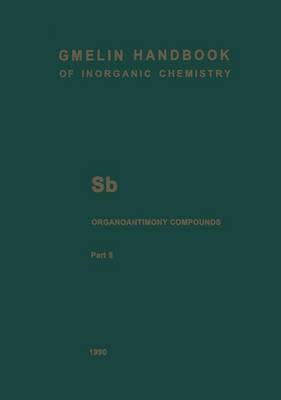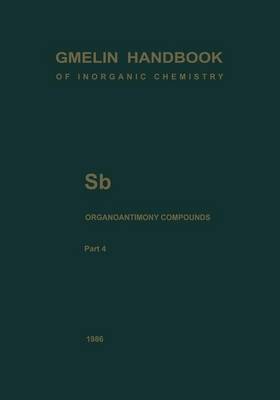Gmelin Handbook of Inorganic and Organometallic Chemistry - 8th edition
2 total works
S-b / 1-4 / 5
This fifth volume on organoantimony compounds continues the description of pentavalent antimony compounds and concludes the entire series. The treatment of pentavalent compounds with three Sb-C bonds began in Part 4 with the RSbX type and is now completed with types RSb(X)Y, RR'SbX , RR'Sb(X)Y, 3 2 3 2 2 2 RR'R"SbX (Section 2.5.1) and the corresponding bi- and trinuclear compounds (Sec- 2 tions 2.5.2, p.87, and 2.5.3, p. 132). R, R', and R" denote different organic groups bonded through carbon to the antimony atom. X and Y represent inorganic or organic groups that are bonded to antimony by an atom other than carbon. R, X, and/or Y can also be chelating ligands. The remaining part of the volume completeLy covers all pentavalent antimony compounds containing two Sb-C bonds (RSbX , RSb(X )Y, RR'SbX , RR'Sb(X )Y, bi- and tetranucLear 2 3 2 2 3 2 compounds, Chapter 2.6, p. 134) and those containing one Sb-C bond (RSbX , RSb(X )Y, 4 3 RSb(X)Y , bi- and trinucLear compounds, Chapter 2.7, p. 237). These compounds form ad- 2 2 ducts with Lewis bases (symbol D) and form many ionic compLexes by the addition of saLts such as amine hydrochLorides (symbol MZ).
The adducts and ionic compLexes are described immediately after the parent substances. The volume concludes with an Empirical Formula Index (p. 318) and a Ligand Formula Index (p. 357).
The adducts and ionic compLexes are described immediately after the parent substances. The volume concludes with an Empirical Formula Index (p. 318) and a Ligand Formula Index (p. 357).
S-b / 1-4 / 4
This fourth volume on organoantimony compounds describes pentavalent antimony com- pounds of the type R and R . The R denotes an organic group bonded by carbon 3SbX2 3Sb=X to the antimony atom. X represents a group, inorganic or organic, which is bonded to the antimony by an atom other than carbon. The X atoms in R may be part of a 3SbX2 ring system. In the case of bidentate X ligands like 02- , S2-, SO~-, CO~-, and others, the compounds are placed with the mononuclear RssbX compounds. 2 I once again thank Dr. Margot Becke and Dr. Ekkehard Fluck for the stimulus that led to this book. To the editor of the former volumes, Dr. Hubert Bitterert gratitude and memory are due. I especially thank Drs. Ulrich Kruerke and Marlies Mirbach for editing this volume, Mrs. Ursula Hettwer for systematically arranging the compounds, and Mr. Edgar Rudolph for preparing the index. Last but not least I thank my wife Sigrid for putting my handwritten manuscript into legible form.
Gramschatz, Altes Forsthaus, June 1986 Markus Wieber x Explanations, Abbreviations, and Units Many eompounds in this voLume are presented in tabLes in whieh abbreviations are used and the units are omitted for the sake of eoneiseness. This neeessitates the foLLowing ctarifieation.
Gramschatz, Altes Forsthaus, June 1986 Markus Wieber x Explanations, Abbreviations, and Units Many eompounds in this voLume are presented in tabLes in whieh abbreviations are used and the units are omitted for the sake of eoneiseness. This neeessitates the foLLowing ctarifieation.

